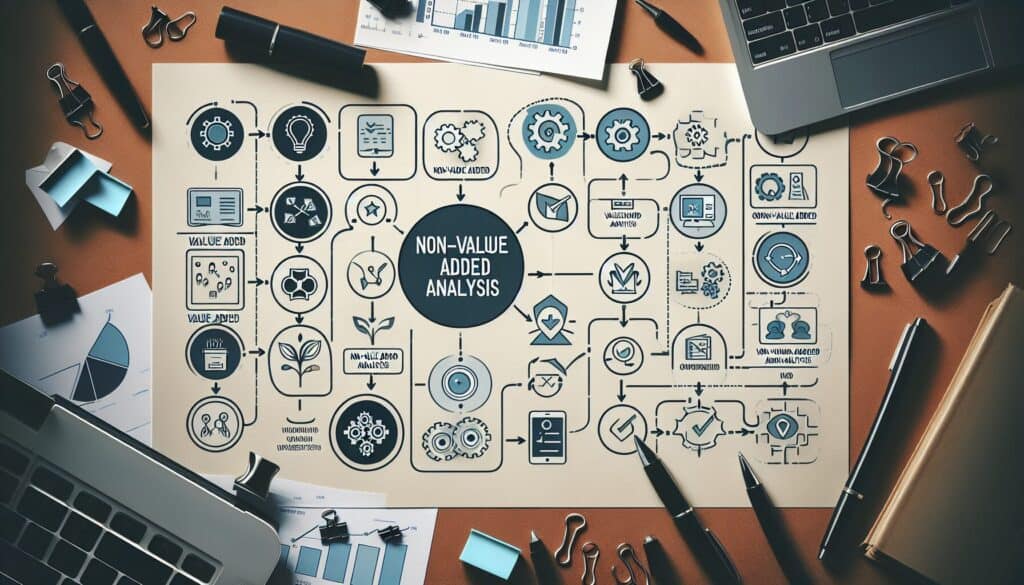Identifier et éliminer ou réduire les activités d'un processus qui n'apportent pas de valeur ajoutée du point de vue du client.
- Méthodologies : Ingénierie, Qualité
Analyse de la non-valeur ajoutée

Analyse de la non-valeur ajoutée
- Amélioration continue, Efficacité, Production allégée, Production allégée, Amélioration des processus, Cartographie des processus, Analyse de la valeur, Ingénierie de la valeur (EV), Réduction des déchets
Objectif :
Comment il est utilisé :
- Il s'agit de cartographier un processus et de classer chaque étape comme étant à valeur ajoutée (VA), sans valeur ajoutée (NVA) ou sans valeur ajoutée nécessaire (NNVA). L'objectif est d'éliminer les activités sans valeur ajoutée et de minimiser les activités sans valeur ajoutée.
Avantages
- Se concentre sur la valeur pour le client ; réduit les déchets et améliore l'efficacité ; simplifie les processus ; peut conduire à des économies significatives et à des délais plus courts.
Inconvénients
- L'analyse détaillée des processus peut prendre beaucoup de temps ; la détermination de ce qui constitue véritablement une "valeur ajoutée" peut parfois être subjective ou dépendre du contexte ; une compréhension approfondie des besoins des clients est nécessaire.
Catégories :
- Lean Sigma, Fabrication, Résolution de problèmes, Qualité
Idéal pour :
- Rationaliser les processus en identifiant et en supprimant systématiquement les activités qui ne contribuent pas à ce que le client est prêt à payer.
Non-Value Added Analysis finds its application across a diverse range of industries, including manufacturing, healthcare, logistics, and information technology, where process optimization is critical. In manufacturing settings, this methodology can be employed during production planning phases to identify inefficiencies in assembly lines or supply chain workflows. Healthcare organizations might utilize it to evaluate patient care processes, helping to eliminate unnecessary steps in patient admissions or treatment protocols, improving care delivery while reducing costs. Similarly, in the context of software development, Non-Value Added Analysis can guide teams in refining their coding and testing phases, ensuring that only activities contributing directly to the software’s functionality are prioritized. Typically, this analysis is initiated by project managers or process improvement teams, bringing together cross-functional participants such as engineers, designers, quality assurance professionals, and stakeholders to ensure various perspectives are considered. Workshops or brainstorming sessions can facilitate a collaborative identification of non-value activities, where participants can share experiences and suggest improvements based on real-world observations. This collective effort not only enhances buy-in from relevant teams but also aids in capturing comprehensive insights into operational inefficiencies, driving a more effective and waste-reducing culture. Through these processes, organizations can effectively shorten lead times and improve service delivery, aligning their operations more closely with customer expectations and willingness to pay.
Principales étapes de cette méthodologie
- Map the current process with detailed steps.
- Classify each step as Value-Added (VA), Non-Value-Added (NVA), or Necessary Non-Value-Added (NNVA).
- Identify NVA activities and document their impact on the process.
- Explore potential improvements for eliminating NVA activities.
- Assess NNVA activities and determine methods to minimize their impact.
- Implement changes to optimize the process based on findings.
- Review and verify the effectiveness of the new process.
Conseils de pro
- Utilize a value stream mapping tool to visualize dependencies and identify bottlenecks that obscure the value-added flow.
- Engage cross-functional teams during the analysis to ensure diverse perspectives highlight overlooked NVA activities.
- Implement regular review cycles post-analysis to adapt and refine the process based on evolving customer needs and feedback.
Lire et comparer plusieurs méthodologies, nous recommandons le
> Référentiel méthodologique étendu <
ainsi que plus de 400 autres méthodologies.
Vos commentaires sur cette méthodologie ou des informations supplémentaires sont les bienvenus sur le site web de la Commission européenne. section des commentaires ci-dessous ↓ , ainsi que toute idée ou lien en rapport avec l'ingénierie.
Contexte historique
1949
1950
1950
1960
1960
1960
1960
1940
1950
1950
1958
1960
1960
1960
1960
(si la date est inconnue ou n'est pas pertinente, par exemple "mécanique des fluides", une estimation arrondie de son émergence notable est fournie)















Articles Similaires
Simulation de Monte Carlo
Tests basés sur des modèles
Contrôle des modèles
Recherche sur les méthodes mixtes
À l'épreuve des erreurs (Poka-Yoke)
Test du profil de la mission